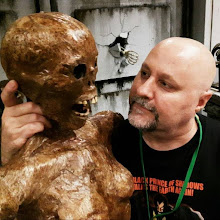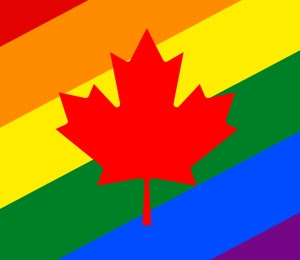Upon the release of UN-DEAD TV in December 2012, I was interviewed by Monica S. Kuebler from Rue Morgue magazine. The edited Q&A appeared in issue #130; the full interview is below.
Monica S. Kuebler: Why a book on vampire television? What inspired you to embark on this project?
In 2009, I was tasked with rewriting the television section for the 3rd edition of J. Gordon Melton’s The Vampire Book: The Encyclopedia of the Undead. While researching the subject, I uncovered an overwhelming number of vampire appearances, much more than I could include in my contribution. I also discovered there was no single volume that specifically covers television vampires; they usually only get a cursory overview, buried within film listings. Considering there have been so many appearances, spanning over 60 years, I realized that the subject demanded further study—so I decided to write a book of my own.
MSK: All told, how long did it take you to research and write this mammoth tome?
After I completed Melton’s project, my research continued for the better part of the next three years. During that time, I also wrote the individual listings, and watched whatever productions I could get a hold of. Even as I was completing the manuscript, I uncovered more appearances, although these quickly became less frequent and more obscure in nature.
Even though Un-Dead TV has been published, the research is ongoing; I continue to catalogue new appearances, as well as seek out the very obscure ones that I may have missed—and I’m posting these updates to the book’s website, http://un-dead.tv.
MSK: How many of the TV shows listed did you actually track down and watch? Which ones were the hardest to find?
I’ve included a selection of foreign-language productions, which were the hardest to track down; as such, I was only able to watch some of them. Overall, I’ve viewed about 75% of the English-language listings—roughly 1300 hours of programming—and I continue to seek out the remaining productions, which are becoming increasingly difficult to find. Thanks to the home video market, I was able to either rent or buy DVDs for many of them, and Netflix helped fill in some of the gaps. I even went through my collection of old VHS tapes, and discovered that I owned or taped several TV documentaries from the mid-to-late 1990s—none of which are currently commercially available. YouTube and similar sites also proved invaluable to my research, as did The Merril Collection of Science Fiction, Speculation and Fantasy at the Toronto Public Library.
MSK: If there were shows you weren’t able to view yourself, what other sorts of research did you conduct in order to write their summaries?
In these cases, it was my goal to cross-reference as much as I could, in order to provide the most accurate synopsis possible. This involved scouring through previously-published books, major online databases, fan forums, and even newspaper archives—anything that provided a hint about the production. I also went directly to the source: I used different social networks and websites to contact writers who penned several of these stories.
MSK: Did the writing this book lead you to any surprising realizations or revelations about how the vampire is portrayed on TV or how that portrayal has evolved over the years?
There’s no doubt in my mind that the vampire would be as ubiquitous in our popular culture were it not for television, and in no other visual medium do you find such a broad and diverse spectrum of stories—and vampires!
Their popularity skyrocketed after the success of the Buffy the Vampire Slayer series in 1997; however, prior to that, there were noticeable spikes in the frequency of related productions. There was one from 1965-69; was this driven in part by the popularity of the original Dark Shadows TV series? Perhaps the spike from 1978-80 was a direct result of the success of Anne Rice’s Interview with the Vampire, first published in 1976. This demands further study; it would be interesting to learn what other pop culture bloodsuckers, or even social trends, influenced these spikes in TV vampire appearances.
Originally just creatures of the night with no voice of their own, bloodsuckers have evolved into something much greater, to become intriguing characters that can have any type of story built around them—something you don’t find with any other monster. Because vampires are the only creatures most like ourselves, storytellers often use them to question the social mores of society, and every generation tends to create their own interpretation of the myth.
MSK: Who is Un-Dead TV for?
Definitely for fans of the undead—and I am obviously one of them! Many TV vampires are icons in their own right; Count von Count, Barnabas Collins, and Grandpa Munster are household names. But these well-known characters are just part of the broad spectrum of the undead that have risen from the coffin over the years. From variety series to documentaries, to telefilms and cartoons, there are over 1000 unique vampire appearances on television—and fans will be amazed at all the different stories being told through their eyes.
Also, considering the range and depth of the listings presented—as well as the inclusion of detailed production information and synopses—Un-Dead TV is a valuable research tool for academics and students studying popular culture. I’ve also included a selection of rare promotional photographs and print ads, which help illustrate the diversity of the television vampire, and showcase how it has been presented over the years.
MSK: What’s your favourite vampire TV show or episode and why? Did it change at all while writing this book?
Actually, this changed from week to week and month to month as I watched more and more productions. Overall, I’d say Angel—Joss Whedon’s Buffy spin-off—is my favourite vampire television series; it’s a shining example of TV drama at its best, supernatural or otherwise. Top episodes include “Bad Blood” from The X Files, and “Fresh Blood” from Supernatural—a series that may soon eclipse Angel as my favourite, now that a vampire plays a major role in the current season.
Some of my favourite telefilms are cult classics, including The Night Stalker (1972), The Halloween That Almost Wasn’t (1979), and The Midnight Hour (1985). One of my favourite variety listings is an obscure Canadian production titled Boo!, a disco-infused, Laugh-In inspired TV special from 1980—hosted by Count Dracula! I found this one in the CBC archives; it’s a shame that such unique programming will likely never get a DVD release.
Despite the occasional misfire, there have been a lot of great vampire stories told on television, and I hope that Un-Dead TV reconnects fans with these often forgotten tales—and becomes a valuable companion into this undead world of television history.








0 comments:
Post a Comment